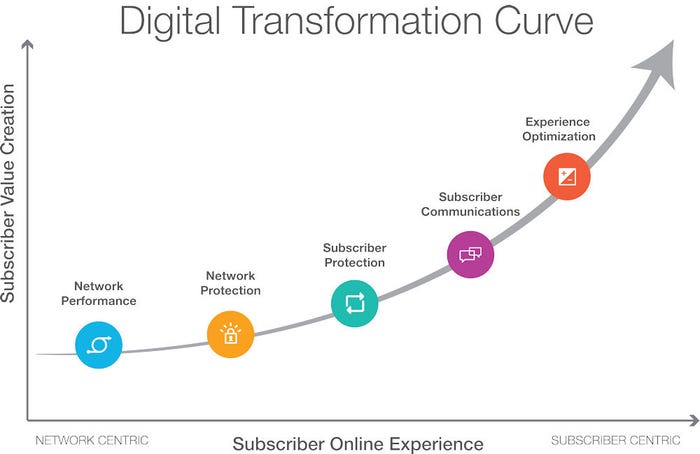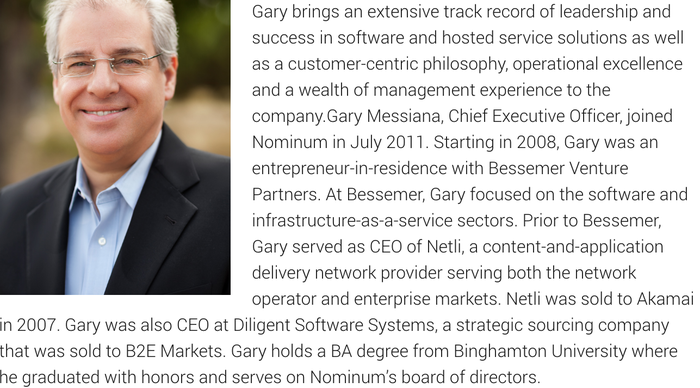Ending the Digital Transformation Paradox
In recent years, the incredible increase in demand for online connectivity, fueled by the mobile internet boom, has created an overwhelming challenge for communication service providers (CSPs), resulting in a market situation we call the “digital transformation paradox.”
September 29, 2016

Telecoms.com periodically invites expert third parties to discuss the biggest challenges facing the telecoms industry today. In this post, Gary Messiana, CEO of Nominum, looks to demystify digital transformation and how DNS can help end the paradox.
In recent years, the incredible increase in demand for online connectivity, fueled by the mobile internet boom, has created an overwhelming challenge for communication service providers (CSPs), resulting in a market situation we call the “digital transformation paradox.” While the digital economy has flourished on the back of their networks, CSPs have been forced to keep pace by investing significant amounts of money in infrastructure. Such financial burdens have made it nearly impossible to commit innovation and development resources to creating higher-value digital services to thwart competition from over-the-top (OTT) players.
Herein lies the paradox: CSPs created the very infrastructure that enabled a thriving digital economy, but, through no fault of their own, have not reaped their fair share of the rewards. They are now turning the tide and moving up the digital transformation curve—a representation of the key steps to achieving digital transformation.
With the supporting infrastructure in place and capacity and cost efficiencies paying off, CSPs are ready to take part in the digital transformation imperative by gaining a holistic view of the subscriber and delivering personalized subscriber services. The number one challenge for CSPs in achieving this integrated customer view is to cost-effectively unify the multiple organizational functions needed to do so. Delivering these personalized services in a cost-effective, scalable and reliable way, while bound by legacy systems, is no easy task. Compounding the problem is the fact that the technology choices for uniting functional silos of people, systems and the functions they perform along this digital transformation curve are limited and prohibitively expensive. Many CSPs are looking to network virtualization to further reduce costs but this approach does not solve the fundamental issue of lack of cohesion between the network, security, customer service, sales and marketing teams that have been tasked with digital transformation imperatives.
Given this scenario, how can CSPs end the digital transformation paradox and become significant competitors to OTT brands that have been using their networks to entice subscribers away—and in some cases even building out their own faster and less costly networks? It’s counter-intuitive but the answer is not investing in new, overly complex subscriber-facing applications from multiple providers. This exacerbates the problem with respect to delayed time-to-value, lack of employee cohesion and increased subscriber confusion. The fastest, most cost-effective way to successfully end the paradox is to look for greater simplicity by finding the lowest common denominator to unify the systems, functions and people CSPs need to deliver an exceptional and personalized subscriber experience. The answer is found in an asset that already exists in every single CSP network today. The answer is DNS—the fundamental building block of the internet.
DNS: The Central Nervous System of all IP Networks
Why is DNS an ideal technology to power the digital transformation shift? While often overlooked as simply being the “phone book” of the internet, DNS has moved beyond the realm of passive internet look-up functionality and is now at the heart of digital transformation. When DNS is leveraged as an active, intelligent resource, it both synchronizes business functions and efficiently delivers premium services that increase subscriber value. An elegant and robust technology, DNS has the ability to deliver innovative, personalized services from end-to-end across provider networks. And, because it already exists in CSP networks, DNS is easily leveraged without extensive cost or complexity.
While many existing suppliers to the CSP segment have recognized these challenges, the solutions they offer are naturally biased toward their position in the physical network. The higher up the stack, the more limited the breadth of their offers and the greater the potential for point solutions to operate in silos. This is exactly what CSPs must reverse to accelerate up the digital transformation curve. Conversely, the lower a supplier’s physical position in the network, the broader and more extensible their offerings can be—an essential concept to ending the paradox.
In our conversations with leading CSPs around the world, top-of-mind issues include overcoming escalating competitive pressures, enhancing subscribers’ ever-increasing digital lifestyles and growing revenue, all while delivering new services and up-selling existing offers. Progressive CSPs now recognize that in order to meet these objectives, they need to sync digital service capabilities with people, processes and systems across the entire business, not just at points along the digital transformation curve. This means bringing marketing, customer service, finance, legal and every other department that has a customer touchpoint along the curve together with the more traditional network and security teams. The days of keeping these groups physically and functionally separated are over. Given its position in the network, DNS plays the perfect role in unifying these teams with efficiency and cost-effectiveness, while supporting the digital lifestyle their subscribers demand.
Extensible DNS: A Platform for Digital, Value-Added Services
Since DNS connects IP addresses with application and service requests, it is now being leveraged across many CSP organisations to create greater subscriber value. It is used to secure the network, protect subscribers, create high-value, premium offers like parental controls, and enable interactive communications that reach 100% of subscribers in a timely and convenient manner.

Industry experts agree that digital transformation requires a more flexible, extensible IT architecture to speed time-to-market of new product and service innovations. A key aspect of this approach is utilizing existing IT systems and complementing them with lightweight, agile platforms that support simplified digital offers and experiences. When properly leveraged, DNS is a high-performance service enabler that meets CSP requirements for flexibility and scalability, while accelerating the delivery of subscriber-centric services that create new streams of revenue and grow market share.
Sue Rudd, director for Strategy Analytics, published a white paper titled “Accelerating Digital Transformation for Communication Service Providers.” In it, she describes four areas that are essential for digital transformation:
Service providers and subscribers gain real-time control over services. For example, families set filters that are activated instantly to match their content preferences.
Integrated IP service management provides simplified management of one platform with unified interfaces for monitoring and provisioning.
Converged solutions ensure subscribers receive the same experience regardless of the network or device they are currently using—whether LTE/cellular, Wi-Fi, cable, DSL or fiber; or smartphone, tablet, e-reader, laptop or PC.
Personalized user access empowers households to create their own unique ‘view’ of the internet and customize settings for every device in the home.
DNS is at the heart of all four of these areas. The CSPs that have put it to work are able to compete more effectively and bring new services to market much faster than their competitors, and will ultimately be in the best position to end the digital transformation paradox. As with many seemingly intractable challenges, simplicity is the right answer, although too often the last place we look.

Read more about:
DiscussionAbout the Author
You May Also Like




.png?width=300&auto=webp&quality=80&disable=upscale)
.png?width=300&auto=webp&quality=80&disable=upscale)




.png?width=300&auto=webp&quality=80&disable=upscale)


_1.jpg?width=300&auto=webp&quality=80&disable=upscale)